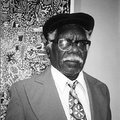Title
Dead man ceremony
1993
Artists
-
Details
- Place where the work was made
-
Ngukurr
→
South East Arnhem Land
→
Northern Territory
→
Australia
- Date
- 1993
- Media category
- Painting
- Materials used
- synthetic polymer paint on canvas
- Dimensions
- 237.0 x 136.0 x 2.0 cm stretcher
- Signature & date
Not signed. Not dated.
- Credit
- Mollie Gowing Acquisition fund for Contemporary Aboriginal art 1993
- Location
- Not on display
- Accession number
- 546.1993
- Artist information
-
 Willie Gudabi
Willie Gudabi
Works in the collection
- Artist information
-
Moima Willie
Works in the collection
- Share
-
-
About
Willie Gudabi had a relatively brief career as a painter, working in collaboration with his wife Moima Willie (born c.1935) for a decade before his death. Nonetheless, he established a significant reputation with highly distinctive narrative paintings centred on initiation and mortuary ceremonies and the stories surrounding them. Gudabi was also a master carver of traditional boomerangs.
Born at Nutwood Downs Station in the Northern Territory, Gudabi grew up in Alawa country in a traditional lifestyle, on the margins of small cattle stations. He worked as a stockman on stations such as Tanumbirini, where he was initiated into the sacred life of his people. By the time Gudabi settled at Ngukurr ('place of many stones' and formerly the Roper River Mission), the settlement had a long history as a gathering point for people of different language groups during years of extreme white aggression. This diverse population was reflected in the radically distinct work of the senior artists that emerged from Ngukurr during the late 1980s. Ginger Riley Munduwalawala and Djambu Barra Barra are fellow artists who were living at Ngukurr at the time and, like Willie Gudabi, took advantage of adult education programmes to begin their painting and exhibiting careers.
Gudabi's preoccupation with death and initiation narratives and rituals of his ancestors takes a consistent form in his work – he paints extraordinarily vibrant images in segmented 'vignettes' across his canvases. The roughly illustrative forms of birds, plants, insects, animals, trees, men, masks, ceremonial events and sites of country are packed together and jostle each other over the surface. Some writers have also suggested that a number of Gudabi's paintings can a so be read as maps, and sometimes illustrate inter-group boundary disputes over custodianship of country.
Notwithstanding that 'Dead man ceremony', 1993, is a mortuary painting, to a general viewer the work appears to be utterly celebratory and highlights the artist's gift as an idiosyncratic and sophisticated colourist. The 'vignettes' or patched sections in this and Gudabi's other paintings are layered, rather than sequential. They interweave, and perhaps are even cyclical in their narratives. The paintings appear to have been viewed by the artist as adjuncts and visual cues in his verbal handing down of stones and the law. They are also 'love stories' in law and the reality shared between Willie Gudabi and Moima Willie, who were married for over 50 years. Like the layered meanings in his spoken narratives, the paintings function at various levels of revelation, according to the knowledge of the viewer involved.
Deborah Edwards in 'Tradition today: Indigenous art in Australia', Art Gallery of New South Wales, Sydney, 2004
© Art Gallery of New South Wales
-
Exhibition history
Shown in 2 exhibitions
Gamarada, Art Gallery of New South Wales, Sydney, 15 Nov 1996–16 Feb 1997
The Dreamers (2009-10), Art Gallery of New South Wales, Sydney, 09 May 2009–15 Aug 2010
-
Bibliography
Referenced in 1 publication
-
Deborah Edwards, Tradition today: Indigenous art in Australia, 'Willie Gudabi', pg. 50, Sydney, 2004, 50, 51 (colour illus.).
-